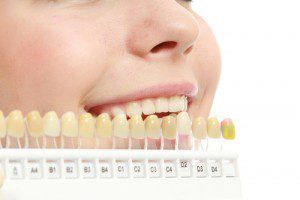 The short answer as to why your teeth have changed colors over the years is because ‘you’re getting older.’ What happens over time is your tooth enamel absorbs inorganic stains and these are stains of everyday life. They could be from food. They could be from smoking. They could be from coffee or tea. Whatever you put in your mouth has the ability to be absorbed into the enamel and make that enamel darker.
The short answer as to why your teeth have changed colors over the years is because ‘you’re getting older.’ What happens over time is your tooth enamel absorbs inorganic stains and these are stains of everyday life. They could be from food. They could be from smoking. They could be from coffee or tea. Whatever you put in your mouth has the ability to be absorbed into the enamel and make that enamel darker.
Enamel is the only thing dentists can bleach. We cannot bleach cementum, and we cannot bleach dentin (the majority of the tooth’s underneath material). Dentin’s natural color is yellow and the enamel covering the dentin is anywhere from a fraction of a millimeter thick up to maybe as much as two millimeters thick which means some of that yellow tint may be seen through the enamel.
As the tooth gets older, the nerve will tend to recede and get smaller and smaller, and as it recedes, it lays down what’s called secondary dentin, which tends to be more yellow than primary dentin.
So your teeth are getting darker over time because of the combination of what the enamel has absorbed over time and the color of the dentin that lies underneath the enamel. This is why teeth whitening, or tooth bleaching, can be very effective. It bleaches out those stains that have been absorbed into the enamel, and you can basically return the color of the enamel back to what it was when you were a kid. In some cases, the teeth actually turn lighter than there were when you were a kid.
